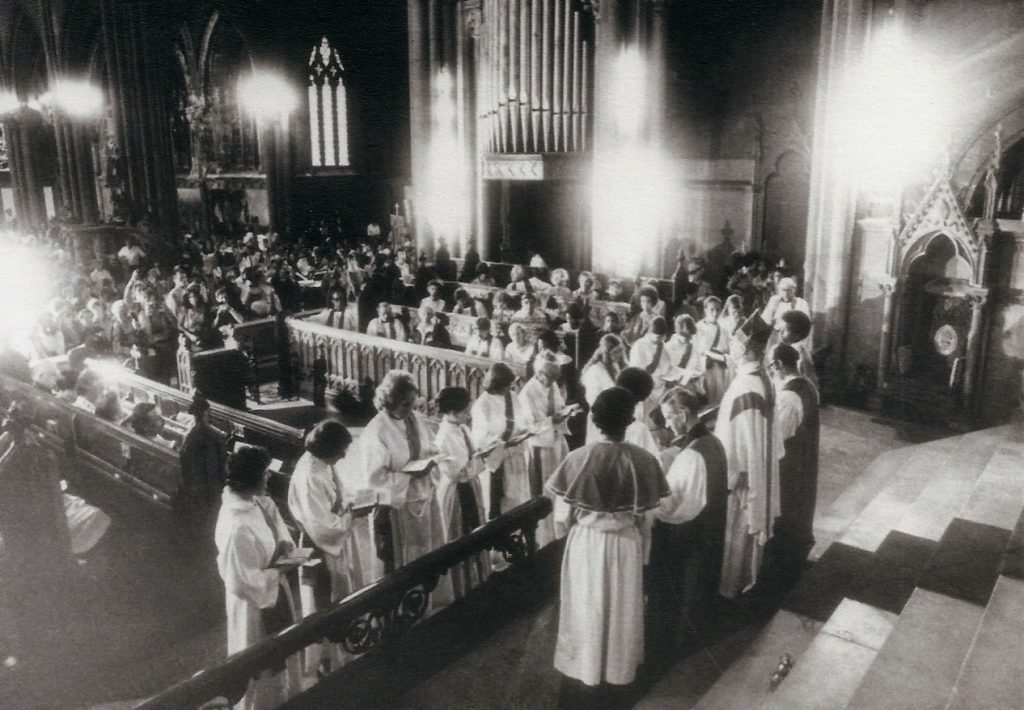
by Patricia Rea
After I was confirmed in seventh grade, I was allowed to be an acolyte in my Episcopal church in Lakewood, Ohio. I lit the candles. I remember getting vested in my acolyte robe in the vesting room of my church. I was 13 years old, shy, and a girl. It was so awkward being in that room, putting on my robe with the boys and our very stuffy male priest. I hated it and couldn’t wait to get out of that vesting room. I didn’t remember, but mother did, that I was never allowed to carry the cross. My mother always noticed things like that: a girl didn’t always get the same opportunities as a boy. That was 1971. A few years later, she heard that a priest in Oberlin was inviting two “irregularly ordained” women to celebrate communion at his church service. She told my dad that we had to go. So we did. That was December 1974. I was a junior in high school.
Peter Beebe, the priest at Christ Church, in Oberlin, Ohio, had invited Carter Heyward and Alison Cheek, two of the “Philadelphia Eleven” priests to celebrate communion. These 11 women had been ordained by four retired Episcopal bishops. The service on that unusual morning was intense, full of media and church officials.
After the service, Peter Beebe met my father, a trial lawyer. When he heard that my father was a lawyer, he told him that he would be put on trial by the Episcopal Church. He asked my father to be his lawyer. My father said, “Yes, on one condition: that there be no fee”. My father had no background in canon law, but he spent the next two years pouring his heart and soul in the Beebe case.
We lived in Rocky River, Ohio, a suburb west of Cleveland. Our house was on Lake Erie and down the steps from our main house was a little beach house, sitting right on the lake. In preparation for the trial, we had many theological experts traipsing in and out of our house, often spending the night in our beach house. The most memorable figure was William Stringfellow, a major theological social activist My mother remembered hearing Mr. Stringfellow over our intercom, singing and praying at the top of his lungs for his morning ritual. Prayer vigils were held at Christ Church, Oberlin and we had the whole community moving to support Peter Beebe.
The issue at the heart of the case was the “Godly admonition” that Bishop Burt of Ohio had given to Peter Beebe, not to invite these women priests to celebrate communion. What exactly was a Godly admonition? The trial took place in the Episcopal Cathedral in Akron, Ohio. Ironically, our own parish priest, the guy in the vesting room, was one of the six jurors for the trial. That jury found Peter Beebe guilty of disobeying his bishop’s Godly admonition. My father was not one to give up, and proceeded to appeal this decision.
In the spring of 1976, the appeal took place in an airport hotel in Michigan. My dad was sick as a dog. My mom didn’t think he was well enough to fly to Michigan and file the appeal. My dad went anyway. The canon law called for men “learned in the Law” to hear the appeal. One of those “learned men” was a woman lawyer. My father pointed to the woman lawyer and said, “Is that one of the men learned in the law?” The appeal was overturned. The Church recommended retrial, but the case was not re-tried. Peter Beebe paid a high personal price and left the priesthood.
The following fall, while I was a freshman at college, I heard on the news that the Episcopal Church had approved the ordination of women.
One of my father’s favorite ways to offer encouragement to any of us was to tell us this: If you’re punching your fist into a brick wall, you never know when you’re going to break through to the other side. My father broke through that wall. For his faith in God.
My father died in October 2011. The assistant priest at our church, St. Peter’s in Lakewood, was Nancy Wittig. She was one of those Philadelphia Eleven priests. Nancy helped to celebrate my father’s funeral and was at the graveside for his internment. She was the last person at his graveside, swinging incense over my father’s grave.
At his memorial service, in St. Peter’s Church in Lakewood, Ohio the priest said that my father had been one of those to “bend the arc of history towards justice. “ Amen.
You can read the original New York Times coverage of the trial here
You can read more about the story of these pioneering women here
John Stuart Rea’s Obituary is here
image: Left to right at the communion rail are Alison Cheek, Suzanne Hiatt, Marie Moorefield (Fleischer), Alla Bozarth-Campbell (Alla Renée Bozarth), Betty Bone Schiess, Jeannette Ridlon Piccard, Merrill Bittner, Emily Clark Hewitt, (Isabel) Carter Heyward, Katrina Welles Swanson and Nancy Hatch Wittig. On the right are ordaining Bishops Robert DeWitt, Daniel Corrigan (seated in front with crucifer Barbara Harris standing on his left) and Edward Welles (center, in mitre). Photo by William F. Steinmetz for The Philadelphia Inquirer, July 30, 1974.

